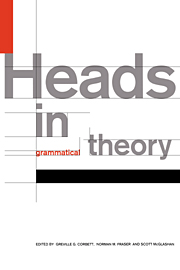Book contents
- Frontmatter
- Contents
- List of contributors
- 1 Introduction
- 2 The head of Russian numeral expressions
- 3 The phonology of heads in Haruai
- 4 Patterns of headedness
- 5 Head-hunting: on the trail of the nominal Janus
- 6 The headedness of noun phrases: slaying the nominal hydra
- 7 Head- versus dependent-marking: the case of the clause
- 8 Heads in discourse: structural versus functional centricity
- 9 Heads in Head-driven Phrase Structure Grammar
- 10 Heads and lexical semantics
- 11 Heads, parsing and word-order universals
- 12 Do we have heads in our minds?
- 13 Heads, bases and functors
- References
- Index
7 - Head- versus dependent-marking: the case of the clause
Published online by Cambridge University Press: 23 February 2010
- Frontmatter
- Contents
- List of contributors
- 1 Introduction
- 2 The head of Russian numeral expressions
- 3 The phonology of heads in Haruai
- 4 Patterns of headedness
- 5 Head-hunting: on the trail of the nominal Janus
- 6 The headedness of noun phrases: slaying the nominal hydra
- 7 Head- versus dependent-marking: the case of the clause
- 8 Heads in discourse: structural versus functional centricity
- 9 Heads in Head-driven Phrase Structure Grammar
- 10 Heads and lexical semantics
- 11 Heads, parsing and word-order universals
- 12 Do we have heads in our minds?
- 13 Heads, bases and functors
- References
- Index
Summary
Introduction
In this chapter I wish to consider the implications of juxtaposing three strands of recent syntactic research that have tended to remain independent of each other. Although there are undeniably differences of emphasis and occasionally of principle, it is part of the contention of this chapter (a) that there is much to be gained from an attempt to bring them together, and (b) that there is less of real substance keeping them apart than is perhaps sometimes thought. The approaches in question are:
The line of typological research inaugurated by Nichols (1986), in particular her fundamental distinction between head-marking and dependent-marking languages.
The focus in the recent generative literature on the properties of functional categories and their projections (Chomsky, 1986a; Abney, 1987; Speas, 1990 and a whole host of other references).
The study of the processes of grammaticalization as a mechanism of syntactic change (Heine, Claudi and Hunnemeyer, 1991; Heine and Traugott, 1991; Hopper and Traugott, forthcoming).
I will begin with a brief characterization of each.
Head-marking versus dependent-marking
This typology assumes a theory-independent and cross-linguistic agreement as to which is the head and which the dependent in any given syntactic construction, and then classifies languages according to whether the head-dependent relation is marked on the head or the dependent. Thus, compare the following:
Maltese bin Alia
son of God
Latin filius Dei
son of God
The Maltese noun iben ‘son’ has a special form bin, the so-called construct state, which is required when it has a nominal dependent. The dependent nominal Alia ‘God’ occurs in the same form as it would if it were an independent element.
- Type
- Chapter
- Information
- Heads in Grammatical Theory , pp. 140 - 163Publisher: Cambridge University PressPrint publication year: 1993
- 4
- Cited by



